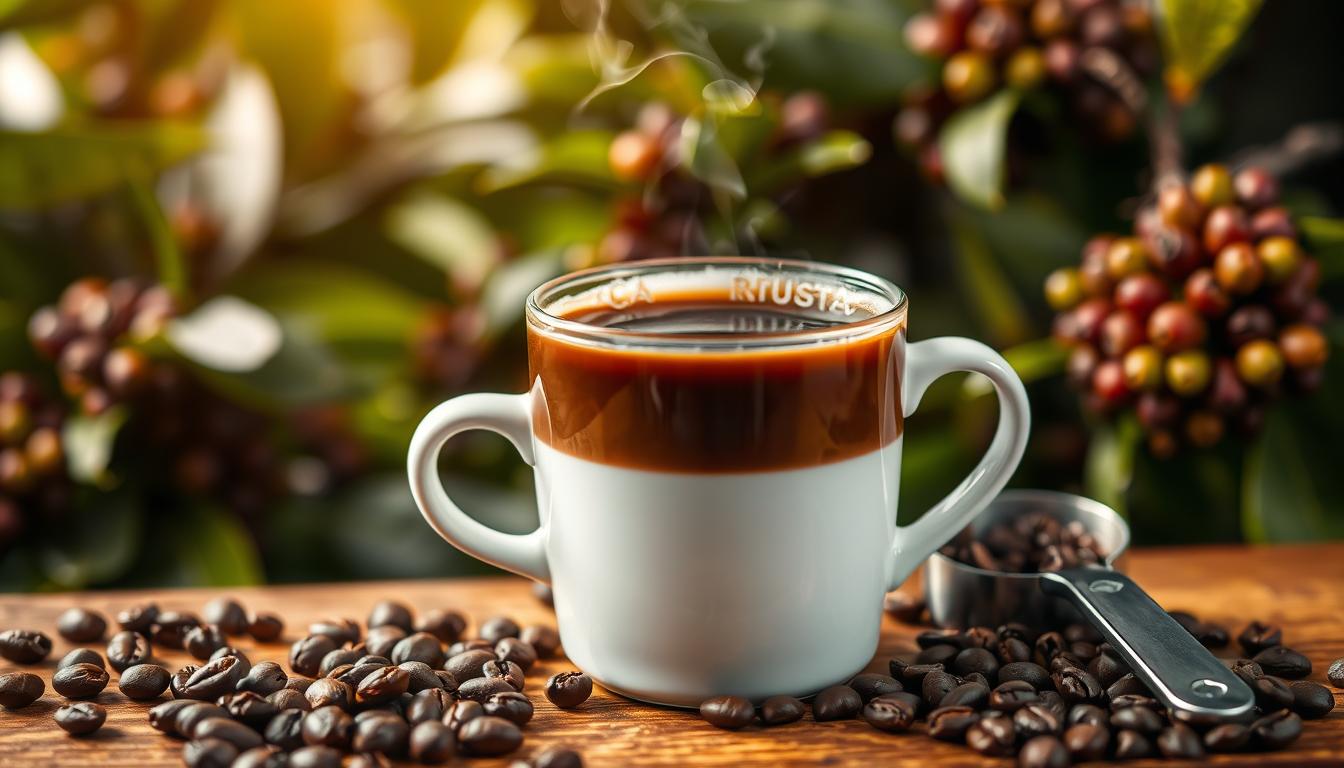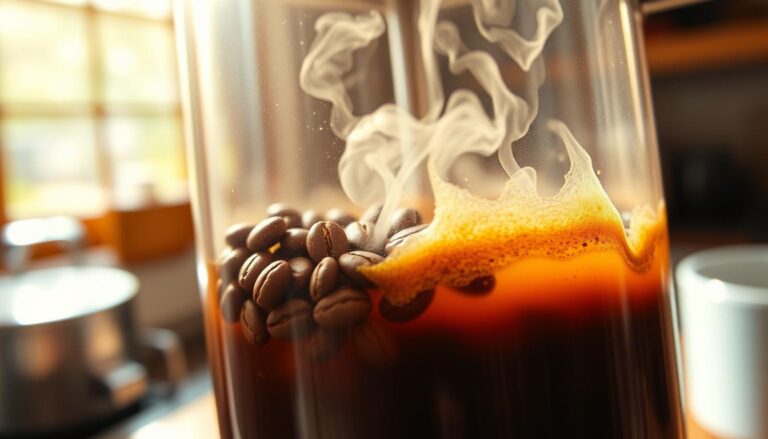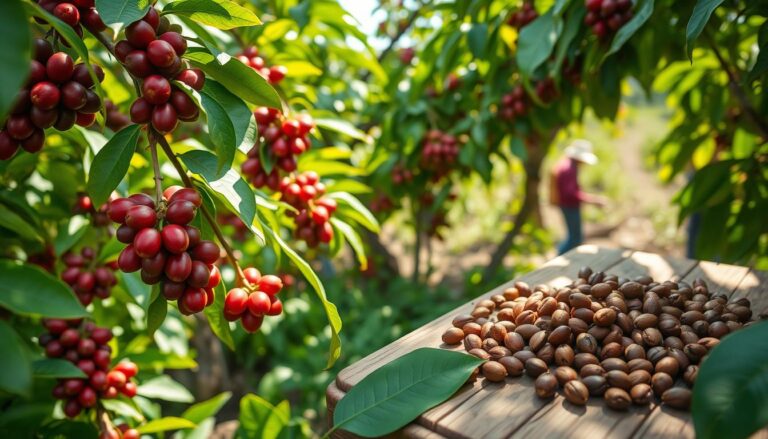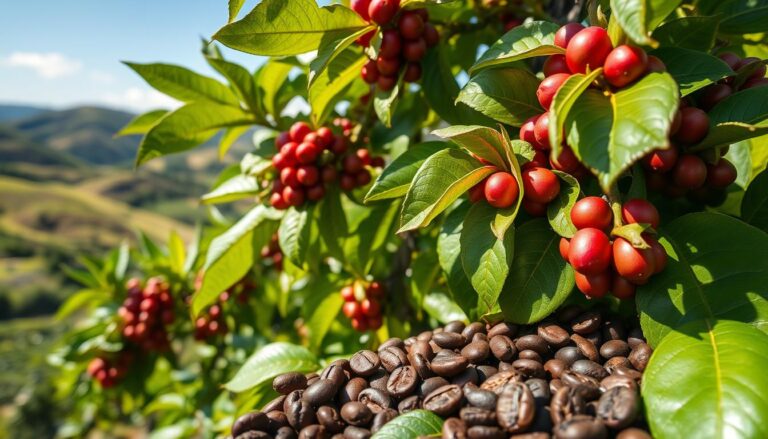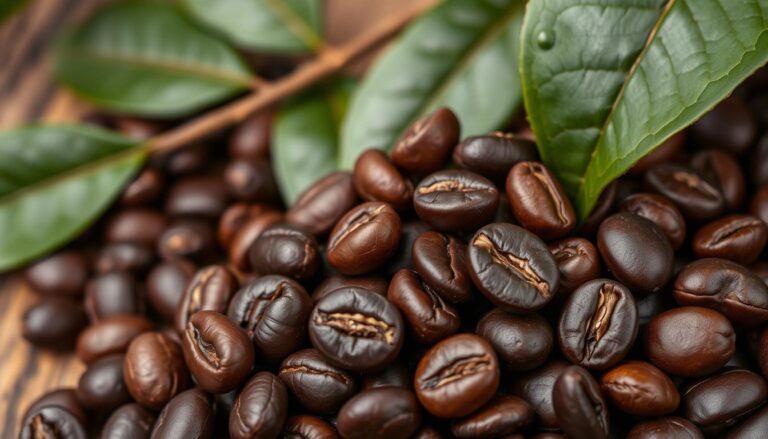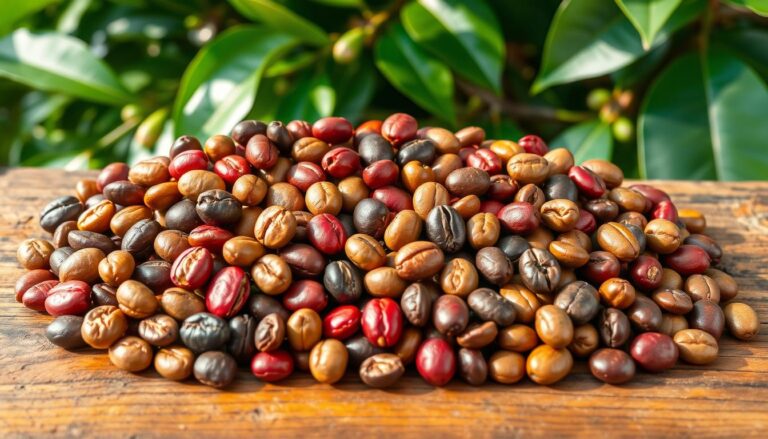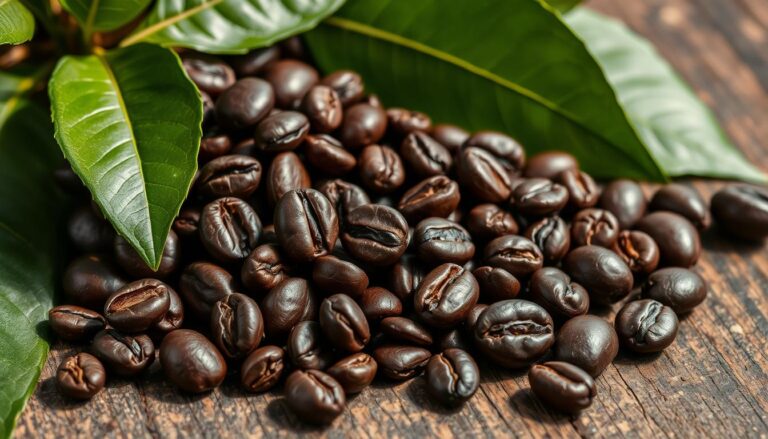Are you ready to discover why Robusta coffee might be the ultimate caffeine powerhouse? As a coffee enthusiast, I’ve delved deep into the world of high-caffeine coffee varieties. I uncovered some fascinating insights about measuring caffeine in brewed coffee that will surprise you.
Robusta coffee beans pack a serious punch when it comes to caffeine content. Unlike its milder cousin Arabica, this coffee variety contains a whopping 83% more caffeine. With an impressive 2.2% caffeine concentration, Robusta beans deliver an intense energy boost that coffee lovers crave.
An 8-ounce cup of Robusta coffee can contain up to 265 mg of caffeine. This makes it a top choice for those seeking a serious morning wake-up call. It outperforms energy drinks like Monster (160 mg) and Red Bull (80 mg).
Key Takeaways
- Robusta coffee contains 83% more caffeine than Arabica beans
- One 8-oz cup can have up to 265 mg of caffeine
- Robusta comprises 40% of global coffee production
- FDA recommends maximum daily caffeine intake of 400 mg
- Caffeine content varies by brewing method and bean type
Robusta Coffee and Its Characteristics
Coffee lovers often talk about the special qualities of different coffee beans. Robusta coffee is a unique type that stands out from Arabica. It has its own special traits.
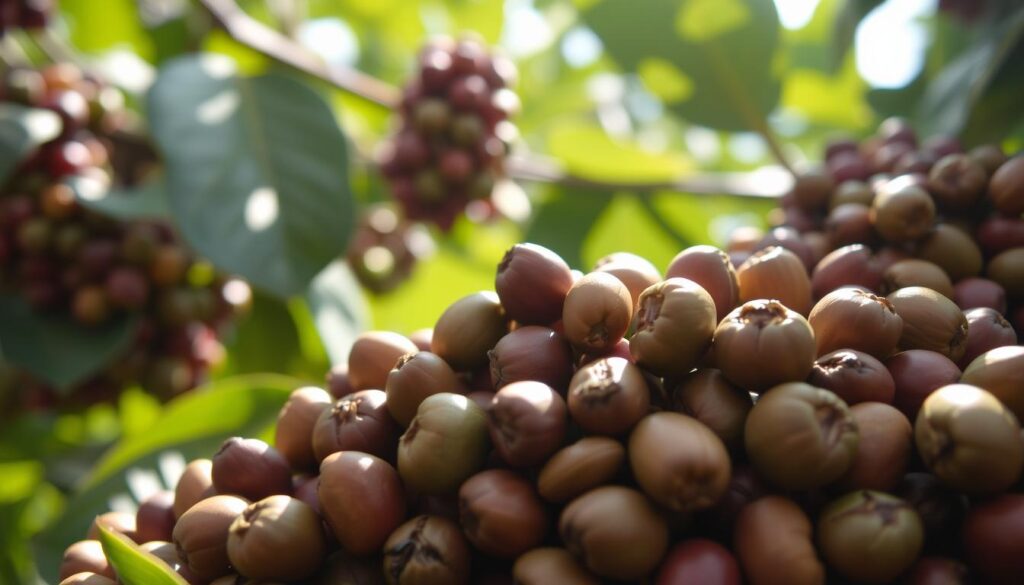
What is Robusta Coffee?
Robusta coffee comes from the Coffea canephora plant in sub-Saharan Africa. It’s known for being strong and hardy. Its beans have unique qualities that make it special in the coffee world.
- Discovered in the 1800s in African regions
- Grows at lower elevations (600-2,400 feet)
- Thrives in warmer temperature conditions
Key Differences Between Robusta and Arabica
Robusta and Arabica coffee have big differences, like caffeine levels. Robusta has much more caffeine, often double that of Arabica.
“Robusta coffee brings an intense flavor profile that coffee lovers either passionately embrace or decidedly avoid.” – Coffee Expert
Robusta’s caffeine makes it stand out:
- More bitter and astringent taste
- Higher resistance to pests and diseases
- Fuller, thicker texture ideal for espresso blends
- Lower acidity compared to Arabica beans
Robusta beans are a big part of global coffee production, making up about 25%. They’re important in the coffee market, even if they’re not as famous as Arabica.
Caffeine Content in Different Coffee Beans
Exploring coffee means learning about caffeine levels in beans. This is important for both coffee lovers and casual drinkers. The type of coffee bean can change how much caffeine you get and your coffee experience.
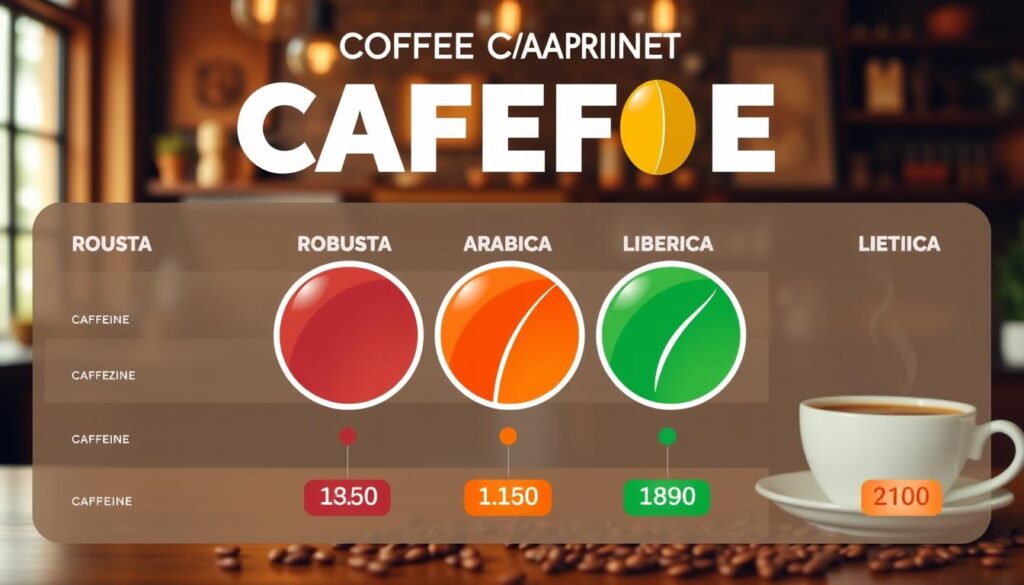
Robusta coffee is known for its high caffeine. Let’s look at how much caffeine Robusta has:
Average Caffeine Levels in Robusta
- Robusta beans have 2.2% to 2.7% caffeine
- An 8-oz cup of Robusta coffee has up to 265mg of caffeine
- One shot of Robusta espresso has about 140mg of caffeine
Comparing Robusta with Arabica Coffee
Robusta has much more caffeine than Arabica beans. Arabica has about 1.2% to 1.5% caffeine. Robusta has almost double that amount. This makes Robusta great for those who want a strong caffeine boost.
“Robusta coffee is the caffeine champion, packing nearly twice the punch of its Arabica counterpart.”
The way you brew coffee also affects caffeine levels. For example, espresso and cold brew have more caffeine than drip coffee.
The FDA says healthy adults can safely have up to 400mg of caffeine a day. Knowing about caffeine levels helps you choose the right coffee for you.
Factors Influencing Caffeine Levels
Exploring the factors that affect caffeine in coffee shows a mix of environmental and processing elements. It’s not just about roasting or brewing. Many variables come into play.
Coffee’s caffeine levels are greatly influenced by where it grows. Environmental factors have a big impact on the caffeine in your coffee.
Climate and Growing Environments
The place where coffee is grown affects its caffeine content. Robusta coffee, with its higher caffeine, grows best in certain conditions:
- Lower elevation regions
- Warmer temperature zones
- Tropical and subtropical climates
“Where coffee grows determines its caffeine punch” – Coffee Research Institute
Processing Methods and Their Impact
Coffee roasting and caffeine levels have a complex relationship. Roasting doesn’t really change caffeine levels. The main factors are:
- Grinding thickness
- Water temperature during brewing
- Extraction time
- Coffee-to-water ratio
My research found that an 8-ounce cup usually has 95 mg of caffeine. This amount can vary based on these processing factors.
Knowing these details helps coffee lovers understand the complexity of their daily caffeine intake.
Health Benefits and Risks of Caffeine
Caffeine is a daily habit for many Americans. Knowing how it affects your health can guide your coffee choices.
Coffee does more than just wake you up. It has many health benefits that are interesting to learn about.
Advantages of Consuming Caffeine
- Enhances mental alertness and concentration
- Boosts metabolic rate and aids in weight management
- Supports cognitive function
- Potentially reduces risk of certain chronic diseases
“Moderate caffeine intake can be a powerful tool for improving daily performance and overall wellness.”
Potential Drawbacks of Caffeine Risks
While coffee has many benefits, there are risks to consider. Too much caffeine can cause health problems.
- Potential sleep disruptions
- Increased anxiety levels
- Rapid heart rate
- Potential dependency
The FDA says healthy adults should not have more than 400mg of caffeine a day. This is about 4-5 cups of coffee. Everyone reacts differently to caffeine, so pay attention to how it affects you.
How to Choose Robusta Coffee
Finding the right Robusta coffee can change your coffee game. It’s all about picking quality Robusta beans and learning how to brew them. This will make your coffee experience better.
Top Robusta Coffee Brands to Explore
Looking for the best Robusta coffee brands? Here are some top picks:
- Lavazza Crema e Gusto – Known for robust espresso blends
- Death Wish Coffee – Acclaimed for extreme caffeine content
- Nguyen Coffee Supply – Authentic Vietnamese Robusta specialty
- Trung Nguyen – Premium Vietnamese Robusta roaster
Mastering Robusta Brewing Techniques
There are many ways to brew Robusta coffee. Try these methods to see how they change the taste:
- Espresso: Highlights Robusta’s intense, bold characteristics
- Cold Brew: Smooths out any harshness
- French Press: Extracts full-bodied flavor and rich crema
“The key to enjoying Robusta is understanding its unique flavor strength and caffeine punch.” – Coffee Roasting Expert
When picking quality Robusta beans, choose fresh, dark roasts. Look for beans from places like Vietnam. They offer some of the best Robusta coffee in the world.
Conclusion: Balancing Caffeine Intake
Exploring Robusta coffee shows how important it is to know about caffeine limits. Robusta beans have almost double the caffeine of Arabica. It’s key to watch how much you drink.
Drinking coffee tips suggest mixing high and low caffeine types. This helps keep your coffee intake balanced.
Robusta coffee has many health benefits, like better brain function and mood. But, how caffeine affects you can vary. It’s wise to listen to your body and adjust how much you drink.
A typical 8-ounce cup has about 95 milligrams of caffeine. This can change your energy and might cause side effects.
Personal Recommendations
If you want a strong coffee, try mixing Robusta with beans that have less caffeine. Or, try different brewing methods. If caffeine bothers you, choose lighter roasts or decaf options.
The goal is to find a balance that gives you energy without too much caffeine. Enjoying Robusta coffee means knowing your caffeine limit. Be aware of how much you drink and how your body reacts. This way, you can enjoy its rich flavors while staying healthy.

